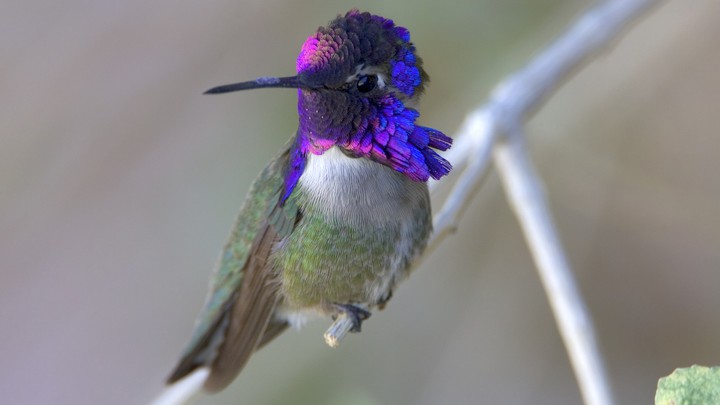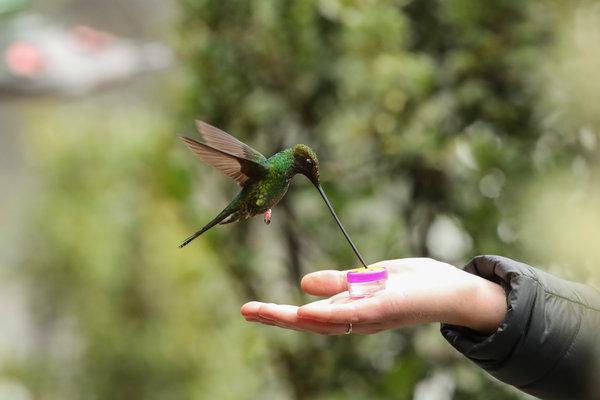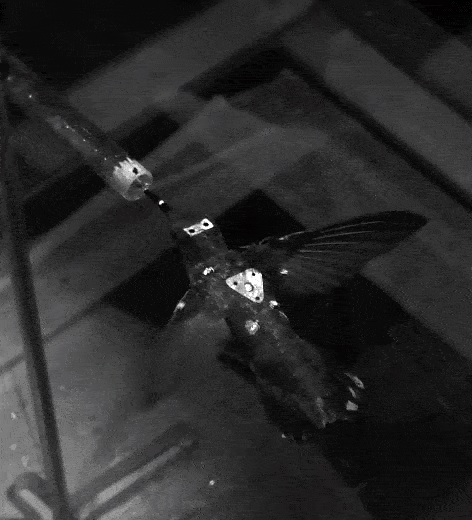Faster, louder, brighter: the physics of the mating "dancing" of hummingbirds

Someone needs a prince on a white horse, who defeated all the dragons in the area (forgive me Targaryen), someone clever and funny, someone just beautiful. But it concerns us, people. In the animal world, especially among our feathered friends, everything is a little different. To gain a favor, the males of different types get up a variety of things: they dance, sing, fight, build nests, steal nests, fight a little more, give gifts, etc. etc. Each species is distinguished by its special “marriage foreplay”. And hummingbirds are no exception. These small but very quick creatures combine speed, sound and color to attract the attention of the ladies of the heart. And now scientists ask themselves: how do the actions of one male differ from those of another? How does the female make a choice, and what is it based on? Today we will find out how scientists transformed hummingbird dance into formulas and graphs, spicing it all up with physical terms. Go.
The main character

Hummingbird is truly a unique creation. Their family has about 350 species, which differ in habitat, physique, diet and habits. A common feature of all species is the small size of the body (from 20 cm to 5.5 cm in length) and a very small weight.

The length of the beak of some species of hummingbirds is longer than the length of their body.
So the largest species, the giant hummingbird, weighs only 20 grams with a body length of ~ 20 cm. Funny, given the presence of the word "giant" in the name of the species. But the smallest species, a hummingbird bee, weighs less than 2 grams with a body length of 5.7 cm.

Small size and weight are great help for hummingbirds to be among the best flyers on the planet. Keeping the same head position, the hummingbirds are able to change the position of the body depending on the flight conditions, that is, on the air currents. Hummingbirds also have extremely sharp eyesight, helping them to recognize the slightest movement.
This paper describes the results of observations of hummingbirds in a wind tunnel.
Hummingbirds use their flying skills not only to hunt insects, hang on flowers, the nectar of which they also feed on, or to avoid unwanted meetings with predators, but also for romantic affairs.
During the nesting period, the male, in order to attract the attention of the female, flies up to 35 meters and falls like a stone. During this rapid decline (about 27 m / s, that is, 97.2 km / h), the overload is very large. If you compare hummingbirds with humans, then with such acceleration even the most experienced pilots could lose consciousness. The hummingbird is considered the record for air diving speed, 2 times ahead of even a skilled predator of the Peregrine Falcon.
When a hummingbird performs his trick, a high sound is heard that is generated by air currents and unusual tail plumage.
Listen to the sound that hummingbirds generate with their plumage.
Add here an incredibly bright color and it turns out three main factors that influence the success of females: speed, sound and color.
It remains to understand how this all is combined, whether there are any evaluation criteria, and how a hummingbird male should dive in order to clearly draw attention.
The basis of the study
To begin with, scientists note that many animals use combinations of signals of different types to attract the attention of a partner. In other words, we see a male dancing or singing, but for a female it is a combination of vibrational, sound and other signals. If they meet a certain "standard", the male can get what he wants.
The difficulty lies in the fact that hitherto very little is known how these signals are perceived, how they are synchronized and in what combinations, what assessment criteria, etc. There are many questions, because scientists decided to conduct this study.
Scientists were able to develop a new methodology for analyzing the structure, functions and dynamics of multimodal signals (when there is a combination of more than one sensory modality). Also, this technique allows to take into account the influence of the object signals (in this case, the hummingbird females), because its sensory and cognitive processes affect the signal structure.
From the point of view of sensory multimodal signals are an excellent irritant. Different signals can amplify and change each other, which enhances their perception by the object to which they are directed.
One of the most important aspects in the formation of a multimodal signal is time, more precisely, the synchronization in a certain order of all the signals involved. This can be compared to singing in humans. Imagine that the singer will start singing the first verse, when the melody of the chorus is playing, and so on until the end of the song. That is, his voice (signal) will not be synchronized with the music (also a signal). It is unlikely that someone would like such singing.

Drevolaz
As an example, scientists cite male wood-dwellers who will not attack an “artificial” male (modelka), unless there is a synchronization of sound (synthetic call-out sounds) and visual (throat-bag pulsation) signals. Make a plastic 100% copy of Drevolaz, put it next to the male, and he will not do anything. Even if through the speakers to turn on the recording of vocation sounds, it will not stir. But if in conjunction with these sounds will be a visual component, there will be a millennium fight.

Tricolor selasforus
In order to understand the synchronization of signals, scientists conducted observations and analysis of the behavior of males of three-colored Selasphorus (Selasphorus platycercus). The males of this species of hummingbird make “dips” (dive) in the air and take off again, thus forming a U-shaped flight trajectory. During the movement, the males make a humming sound generated by the tail. In addition, the breast of the males is colored bright red, which is also a visual signal. All this in aggregate is nothing but a multimodal signal.
The researchers conducted a quantitative analysis of 48 dives. During the observations software was used for image tracking and acoustic analysis. Also, scientists evaluated the resulting signature from the position of the female, given the Doppler effect. In addition, a hummingbird's color perception model was used to assess the importance of coloring a male as a visual signal.
Observation results
After observing the crazy stunts of male hummingbirds, scientists calculated an average fall rate of 23.25 m / s, which is approximately equal to 83.7 km / h. The time from takeoff to the completion of the peak was about 6.4 s.

Image No. 1: data after observations (trajectory, speed / sound, frequency of sound signals, changes in the color of the breast).
Sound analysis showed that the sounds generated by the wings and tail can be divided into three components, which are shown in image 1b . The first part (A, the purple line) of the sound arises due to the wings during the descending and horizontal direction. Between these directions, where the male begins to take off, there is a characteristic buzz created by the tail. After takeoff, there are short sound gaps (B and C), which are characteristic of this type of bird during takeoff.
Given the complexity, the sound signal is dynamic, increasing in the fall and decreasing during takeoff. Due to the Doppler effect, the perception of the female of this signal increases by ~ 6.5% when the male approaches, and decreases by ~ 4% when it is removed.

Image number 2
In order to understand how females perceive changes in the color of the breast of the males, the scientists used photographs of museum exhibits in the ultraviolet spectrum, taken at different angles. The obtained information was combined with the data on the position of the male body at different times of a dive. As a conclusion - the male breast will be visible only when his body is at a certain angle relative to the stationary female. For the calculations it was proposed that the viewing angle of 0 ° corresponds to the orthogonal position of the male body relative to the female ( 1e ). Thus, the male breast will be visible to the female only in the range of −80 ° (when its beak is directed toward the female when approaching) to 60 ° (when its beak is directed from the female at a distance). Outside of this range, the male breast is covered by his own body and is innocent to the female.
Using the computational model of the female's color perception system, the scientists found out that the color of the male's breast changes greatly in the diving process (in the female's perception). The color changes from bright red to dark green ( 1e and 2c ). The whole process of changing colors takes about 120 ms.
The most significant observation is not a visual change of color or even the generation of sounds by the tail, but the synchronization of all signals into one single structure ( 2a ).
When the male reaches the top of the horizontal axis of the trajectory, he straightens the tail plumage, which leads to the generation of the buzzing sound ( 2d and 2e). At the same time, for 300 ms, he demonstrates his colorful collar (breast). In this incredibly short period of time, the perceived frequency of buzzing increases, and the male itself is located as close as possible to the female. In other words, the male moves away from the object of desires (female), accelerates, turns on the music, and being next to her, effectively shows his suit to the accompaniment of his tail unit, which has increased due to the Doppler effect.
For more information about the details of the study I recommend reading the report of scientists and additional materials to it.
Epilogue
Scientists are well aware that they still know very little about how signals are perceived by different animals during their intercourse. However, in this study, they were able to confirm the importance of two aspects - synchronization and multimodality, which are important for enhancing the perception of both individual signals and their combination.
As it turned out, the hummingbird males do not just show off in front of the females, but try to align the best trajectory in order to even more effectively capture the attention to their person.
The world of wildlife continues to amaze and touches us. What we consider to be an ordinary dance or flight for the sake of attention is in fact a complex set of signals that conceal many physical phenomena and biological processes. As they say, not everything is as simple as it seems at first glance.
PS
Dear friends, I would like to once again heartily congratulate you on the coming new year. Last year gave us a lot of new discoveries, amazing research and very funny observations. The world is replenished with new knowledge every day, and I hope that this year we will see this more than once.
Remain curious, love science, get to know the world in all its unimaginable and diverse beauty. Happy New Year guys! :)
Although today is not Friday, but here's your Friday extraordinary offtopic (in honor of the holidays, so to speak):
Swans are one of the most sophisticated birds on the planet, and their dances are appropriate.
In this video, we can see all the various methods of attracting the attention of males from the family of birds of paradise: from wild dances to the demonstration of building skills.
Video showing the meeting of the Galapagos albatross after a long parting. These are monogamous birds, creating a couple of times and until the death of one of their partners.
Swans are one of the most sophisticated birds on the planet, and their dances are appropriate.
In this video, we can see all the various methods of attracting the attention of males from the family of birds of paradise: from wild dances to the demonstration of building skills.
Video showing the meeting of the Galapagos albatross after a long parting. These are monogamous birds, creating a couple of times and until the death of one of their partners.
Thank you for staying with us. Do you like our articles? Want to see more interesting materials? Support us by placing an order or recommending to friends, 30% discount for Habr's users on a unique analogue of the entry-level servers that we invented for you: The whole truth about VPS (KVM) E5-2650 v4 (6 Cores) 10GB DDR4 240GB SSD 1Gbps from $ 20 or how to share the server? (Options are available with RAID1 and RAID10, up to 24 cores and up to 40GB DDR4).
VPS (KVM) E5-2650 v4 (6 Cores) 10GB DDR4 240GB SSD 1Gbps until spring for free if you pay for a period of six months, you can order here .
Dell R730xd 2 times cheaper? Only we have 2 x Intel Dodeca-Core Xeon E5-2650v4 128GB DDR4 6x480GB SSD 1Gbps 100 TV from $ 249in the Netherlands and the USA! Read about How to build an infrastructure building. class c using servers Dell R730xd E5-2650 v4 worth 9000 euros for a penny?
